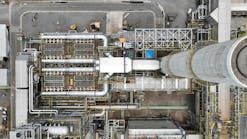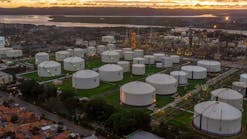New Zealand refiner commits to efficiency upgrades, emissions cuts
New Zealand Refining Co. Ltd. (Refining NZ), the country’s sole refiner, has entered an agreement with New Zealand’s Energy Efficiency and Conservation Authority (EECA) to further reduce the carbon footprint of its 107,000-b/d Marsden Point refinery at Northland, 160 km north of Auckland.
As part of a commitment signed in mid-October with EECA to make a meaningful contribution to New Zealand’s climate change obligations, Refining NZ will carry out a 3-year energy management program in which it will execute a series of projects designed to increase energy efficiency as well as reduce emissions of carbon dioxide at the Marsden Point refinery, EECA said.
The agreement follows the operator’s recent commissioning of its $365-million (NZ) Te Mahi Hou (TMH) expansion project, which included installation of a continuous catalyst regeneration (CCR) unit to enable the refinery to process increased volumes of a wider range of crudes more effectively and efficiently (OGJ Online, Mar. 10, 2016).
Alongside increasing the refinery’s production volumes and improving overall profitability, TMH focused on improving environmental performance of the manufacturing site.
Extensive work to improve operating efficiencies of processing units completed during TMH already has reduced the refinery’s CO2 emissions by about 120,000 tonnes/year, said Sjoerd Post, Refining NZ’s chief executive.
“Having completed TMH, the door is open for microenergy projects—all part of our strategy of pursuing small, quick pay-back investments that lift our energy profile and grow revenue while improving our environmental footprint,” Post said, adding that he sees great potential to further slash energy use at the site by optimizing refinery pumps, fans, and process heating systems.
While Post did not elaborate on the scope of projects to be executed under the energy management program, he did say the company expects to save at least 10 Gw-hr/year, or the equivalent energy use of 1,100 households and 2,300 tpy of CO2.
The Marsden Point refinery is one of New Zealand’s largest users of electricity and process heat (steam, hot water, and direct-heat systems), EECA said.
Operations update
Despite lower crude prices and sustained gasoline demand in the US, China, and India offering relatively stable support to global refining margins, expectations of an extended period of near-term pressure resulting from product overhang has led Refining NZ to revise its capital spending program to refocus on small to medium-sized investments aimed at maintaining safe operation of the refinery and increasing its ability to complete with imported fuel products, the company said in a series of August-September reports to investors.
In line with the company’s previous strategy of maximizing plant reliability and executing growth projects with attractive payback periods, Refining NZ said it continues to progress on a series of initiatives to grow revenue and contribute to the ongoing competitiveness of its business, including:
• Doubling the refinery’s intake of natural gas by early 2017 to enable increased, cleaner crude processing activities. Following availability of new transmission capacity in 2017, the refinery will increase its natural gas intake to more than 5 petajoules/year vs. its current intake of 2-2.5 petajoules/year, according to Refining NZ’s 2015 annual report.
• Bringing bigger cargoes of crude oil to Marsden Point so that up to half of the refinery’s delivered crude shipments (about 20 million bbl/year) arrive on ships carrying 1 million bbl at a time vs. current ship deliveries of 500,000-700,000 bbl), which would reduce refinery ship traffic as well as improve freight economics.
• Increasing capacity on the Refinery-Auckland pipeline (RAP) by about 15% via a three-phased project to ensure the refinery continues to meet product demand for Auckland’s growing population. (During 2015, product throughputs along RAP—which runs underground from the refinery to a terminal at Wiri in South Auckland—stood at about 18.5 million bbl total.)
As of late September, Refining NZ’s investment in small, high-payback growth projects amounted to $4 million (NZ), which includes investment in Phase 1 of the RAP capacity expansion.
Further details regarding the proposed RAP capacity expansion, however, were not disclosed.
By yearend, the company said that, alongside ongoing implementation and unit optimization of TMH, it plans to complete deconstruction of the refinery’s decommissioned semiregenerative catalytic platformer, which was taken out of service last year following startup of TMH’s CCR unit.
Contact Robert Brelsford at [email protected].


